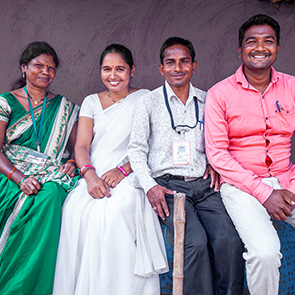At Johnson & Johnson, we view innovation in data science and digital health as a critical engine of our long-term business success and the foundation of our positive contribution to sustainable development and an equitable and inclusive society.
Across our sectors, we combine innovative technologies with leading science to deliver care in groundbreaking new ways. With a vast and diverse portfolio of digitally powered treatments and solutions, we aim to keep people well at every age and stage of life.
Jim Swanson
Executive Vice President, Chief Information Officer, Johnson & Johnson
Data science and digital health in Pharmaceutical R&D
The potential of data science and digital health to revolutionize healthcare is immense. As the largest, most diversified healthcare products company, Johnson & Johnson is using data science and digital health to reimagine the discovery and development of medicines and advance our mission of bringing transformative treatments and vaccines to patients around the world. These methods are fundamentally shaping the way we think, work and solve problems across our R&D portfolio. Through more than 100 data science projects spanning our top development portfolio assets, we are driving transformational innovation and impact for patients.
Najat Khan, Ph.D.
Chief Data Science Officer and Global Head, Strategy & Operations, Janssen R&D
The application of data science and digital health in our pharmaceutical R&D programs is helping to transform how we innovate. Examples from among the many ways that AI, ML and other data science methods are being leveraged include:
- Bladder cancer trial recruitment: Janssen established a collaboration with Paige, a global leader in clinical AI applications in pathology, to deploy a first-of-its-kind, AI-powered biomarker test, developed by Janssen, to screen for the presence of certain alterations in the fibroblast growth factor receptor (FGFR) genes in patients with advanced urothelial cancer, also known as bladder cancer. The goal is to provide physicians with insights to help tailor patients’ treatment plans and facilitate clinical trial recruitment. The biomarker test was validated through Janssen clinical trials and subsequently deployed for screening patients across clinical sites. This marks an important advancement in medicine and data science, demonstrating the potential for more rapid, optimized care for patients in need.
- Early detection of pulmonary hypertension (PH): The FDA granted Breakthrough Device Designation for an AI-enhanced, Pulmonary Hypertension Early Detection Algorithm, developed in collaboration between Janssen; Anumana, a health technology company; and Mayo Clinic. The algorithm is a precise, non-invasive screening tool that could help address the unmet need for earlier diagnosis of patients with PH, which may otherwise go unnoticed until the disease has advanced to the point of limiting treatment efficacy. Downloadable by a physician to a digital device or accessed via the cloud, the algorithm will be accessible for broad-scale use in early detection of PH, if approved.
- Engaging patients remotely to study immune-mediated skin conditions: We launched a remote immunodermatology observational study to capture more than 100,000 images from patients living with immune-mediated skin diseases to support the development of AI algorithms needed for creating objective measures of disease severity on diverse skin types. In our study, patients used their smartphone to capture photos of their skin over time, creating a unique data set with the volume required for detailed analysis. Currently, the severity of immune-mediated skin conditions is measured by doctors using the naked eye, which may lead to high variability in severity assessment. In this digitally enabled remote study, we are generating new ways of assessing immune-mediated skin conditions, enabling improved treatment solutions in the future. Moreover, by offering the ability to assess skin conditions remotely, technology is helping to reduce the burden on patients who otherwise would be required to take time from work and family to visit a doctor’s office or clinical center. This is one example of how Johnson & Johnson is leveraging digital tools to help improve clinical trial diversity by reducing the burden of participation in clinical studies.
- Enabling healthcare self-management: In 2022, we developed a disease-agnostic, digital health platform and initiated the first clinical study utilizing the platform in collaboration with the University of Nairobi (UoN) and local tech company, the Savannah Global Health Institute. The platform, called myCareHub, is being tested with young people living with HIV in Kenya and was integrated into the clinical sites managed by UoN under the Kenyan health system. It was developed to educate, empower and provide remote support for patients to manage their own health by linking their medical records into a secure digital vehicle, facilitating engagement with their HCP and connections to other patients. Janssen has made myCareHub available via a non-exclusive, royalty-free license to UoN. The experience gained will help guide further development of the platform and lay a foundation for potential future implementation across other regions.
Delivering medical technology intelligence
The future of medical technology will be smarter, less invasive, and more personalized. Digital technology is helping enable this future, delivering data intelligence for personalized patient outcomes, more focused precision and efficiency in the operating room and accelerated innovation across the industry. Advanced analytics and data science practices are impacting the medtech industry, as connected devices, robotics and software solutions generate valuable, connected data. In MedTech, we are embracing the power of data science to transform the way we help deliver more personalized healthcare for better patient outcomes, as well as the way we run our business.
- Improving AFib treatment: Due to the complexity of AFib and a myriad of decentralized data, cardiac electrophysiologists and manufacturers struggle to generate consistent results across patients and operators. Biosense Webster introduced CARTONET, the first cloud-based data management system that has the potential to improve procedure efficiency and outcomes. Using a deep learning algorithm, CARTONET evaluates patterns, enabling physicians to assess their performance more easily. CARTONET is compatible with CARTO, Biosense Webster’s 3D mapping system that integrates all our electrophysiology mapping and ablation catheters.
Ashley McEvoy
Executive Vice President, Worldwide Chairman, MedTech, Johnson & Johnson
- Improving efficiency and accuracy of knee surgery: DePuy Synthes uses ML to right-size total knee arthroplasty (TKA) and total hip arthroplasty (THA) implants. By creating and deploying ML-driven predictions for TKA and THA procedures using direct customer electronic medical records, DePuy Synthes can tailor the list of required components to meet the need of each specific surgery, rather than delivering all possible standard sizes. This makes surgery coordination more efficient and accurate.
- Automating imaging for improved eye disease diagnosis: Using a custom-designed, ML- and AI-driven device, Johnson & Johnson Vision has automated the processing of meibomian gland (MG) imaging, leading to better understanding of a patient’s MG disease. MGs produce meibum, an oily substance that prevents evaporation of the eye’s tear film, necessary for full eye health. Connecting the new device to Johnson & Johnson Vision’s LIPISCAN imager enables consistent evaluation of a patient’s MG disease based on real-world outcomes, enabling better diagnosis and medical intervention.
Empowering our teams for digital innovation
As a large and diverse organization, applying digital tools across many dimensions of our work in digital health and processes, we invest in sharing our work and progress internally, encouraging learning and reapplication of successful ideas and creating awareness for the latest technologies among our teams. In 2022, Johnson & Johnson’s Data Science Council published its internal Data Science Business Impact Report showcasing the most compelling examples of how teams from R&D, commercial, supply chain and Enterprise functions are working to make the promise and potential of data science a reality.
We also held our annual Janssen R&D Data Science & Digital Health Symposium, bringing together more than 2,000 colleagues for two days of discussion and presentations on how Janssen R&D is using data science and digital health as a transformational force in medicine and for patients. More than 75 data science and digital health projects were showcased at the Symposium, and more than 200 speakers, including experts from across industry, startups and academia as well as Johnson & Johnson executives, shared their insights.
Peter Fasolo, Ph.D.
Executive Vice President, Chief Human Resources Officer, Johnson & Johnson








